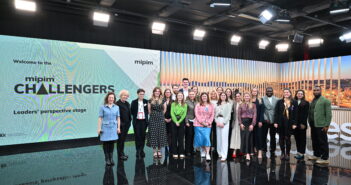Collaborating with scientific organisations, financial institutions, health units, R&D centres, industrial partners and other businesses, the Quebec-based start-up uses state-of-the-art tech to monitor a common problem in industrial waters – legionella bacteria.
According to CEO and co-founder Étienne Lemieux, commercial properties dealing with quantities of industrial water, due for example to the presence of cooling towers, have traditionally used large amounts of chemicals in disinfection procedures to control the proliferation of pathogens. However, this extensive use of biocides has a monetary and environmental cost. Thus, the SPI Bio tech tool analyses the appearance of bacteria, alerting firms only when levels require an intervention – saving on expense and improving a building’s sustainability footprint.
“We were inspired to launch the project in 2014, following a significant incident in 2012 in Quebec where 184 people were sent to hospital,” Lemieux explains. “A commercial building caused the outbreak, with the high number of casualties due to the cooling tower exposing people to legionella bacteria for 58 days. City-wide regulation followed, inspiring our biotech solution.”
Widespread problem
A similar outbreak in 2015 in New York, where 14 people were sent to hospital, also produced a state-level reaction. Today, buildings in the US state are required to carry out monitoring of industrial waters every 90 days. However, Lemieux cautions that legionella outbreaks are still on the rise in both Quebec and New York, as the laws don’t really go far enough.
“City-level legislation is all about reducing the time of potential exposure to the bacteria, but every 90 days isn’t really enough to halt an outbreak,’ Lemieux explains. “A cooling tower has an eight-mile radius. In fact, legionella outbreaks are on the increase as it takes just a week and a half for a system to go from clean to dirty.”
In recognition of the risks, New York is in fact shaping up into another territory of interest for SPI Bio. “We’ve just concluded a partnership with a New York hospital,” Lemieux confirms. “Beyond that, we have our sights set on expansion in Florida and New Jersey, again due to legislation trends. That means we’ll be in the US before we reach West Canada.” Between them, these incipient markets are likely to keep SPI Bio busy for a while. “In Canada there are around 15,000 cooling towers, while there are around 300,000 in the USA,” he adds.
On-site monitoring
Without SPI Bio, legionella checks would typically involve the use of technicians to take samples and send them to labs, but SPI Bio removes the need for onsite specialists with its installed monitoring equipment.
“Our detection tool takes measurements every day, helping managers to understand legionella levels,” he explains. “There’s actually virtually no margin of error as the tech can read the DNA of the bacteria, creating a measurement which is eight times more sensitive than that which legislation requires. When legionella figures are rising in a system, the equipment would register a hit several days before it reaches levels which represent a health risk. The equipment doesn’t require anyone to operate it – it simply sends an email or text to the manager. It also checks for the genetic code of similar micro-organisms, producing a full health check.”
Lemieux notes that the problem of legionella will never entirely go away, but that the right approach makes it entirely manageable, with the detection mechanism replicable for other micro-organisms.
“There will always be some level of legionella bacteria in systems – it comes from the rain, from cooling towers, from lakes and rivers,” he notes. “By detecting and sharing levels every day, there’s much more control over the process – it massively reduces the need for chemical treatment.”
The PropTech solution also translates into significant savings, Lemieux explains. “One of my clients has made a saving of $35,000 per year in chemical spend alone. The point is that firms use biocide for two reasons – the first is simply for legionella control, while the second is to meet legislative targets. Twenty years ago, no one was putting this much chemicals into water systems. Regulation has driven a 20% increase in chemical consumption, with many firms adding more as a security hedge. But it’s not a positive trend.”
He adds: “Chemicals reduce the life expectancy of equipment, as well as worsening a building’s environmental footprint as it means more chemicals down the drain. Cooling towers take water from public systems and some of the treated water will go into the sewer. You have to remember that a few of these chemicals are cancer causing – they’re highly toxic biocides.”
Future solutions
Currently, the tool only alerts to levels of risk, rather than applying the solution as well. “In the future, we hope to also provide a solution as well – chemical or otherwise – that’s something we’re working on. Most of our clients have dedicated staff to deal with that, but for clients that don’t have technicians, we hope to be able to offer a complete tool.”
According to Lemieux, controversy around chemical use means that potential solutions could look beyond regular biocides, also harnessing the power of tech. “There’s a shift in the industry away from just using chemicals to treat water,” he says. “A lot of research is still in its infancy, but ideas ranging from UV treatment to electromagnetics and electrolysis cures are part of a really exciting, emerging area of PropTech and BioTech.
“Ultimately, cooling and heating are a big part of a property’s footprint on the environment. We need to move on from how we used chemicals 20 years ago, and we’re happy to be part of the solution.”



